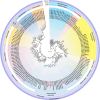Identification and characterization of novel CRESS-DNA viruses in the human respiratory tract
- PMID: 40588733
- PMCID: PMC12207797
- DOI: 10.1186/s12985-025-02742-6
Identification and characterization of novel CRESS-DNA viruses in the human respiratory tract
Abstract
CRESS-DNA viruses are small, circular, single-stranded DNA viruses that have been identified in diverse environments and hosts, including vertebrates, invertebrates, and environmental samples. However, their diversity and role in the human respiratory tract remain poorly understood. In this study, we employed viral metagenomics to analyze 140 nasopharyngeal swab samples from asymptomatic individuals. High-throughput sequencing and bioinformatics analyses were used to identify and characterize novel CRESS-DNA viruses. Phylogenetic relationships were inferred based on Rep protein sequences using maximum likelihood analysis. We identified and characterized eight novel CRESS-DNA viruses, which were classified into the families Endolinaviridae and Naryaviridae, with one potentially representing a novel viral family. These viruses exhibited typical circular genomic structures encoding Rep and Cap proteins, with conserved motifs associated with rolling circle replication. Phylogenetic analysis showed that some viruses were closely related to sequences from vertebrate hosts or environmental samples, suggesting a diverse ecological distribution. Our findings expand the known diversity of CRESS-DNA viruses in the human respiratory tract and highlight their potential ecological and evolutionary significance. Further studies are needed to explore their host specificity, replication mechanisms, and potential roles in human health and disease.
Keywords: Cressdnaviricota; Endolinaviridae; Naryaviridae; Metagenomics; Phylogenetics; Respiratory tract.
© 2025. The Author(s).
Conflict of interest statement
Declarations. Competing interests: The authors declare no competing interests.
Figures




Similar articles
-
Improvement of Nanopore sequencing provides access to high quality genomic data for multi-component CRESS-DNA plant viruses.Virol J. 2025 Mar 18;22(1):78. doi: 10.1186/s12985-025-02694-x. Virol J. 2025. PMID: 40098028 Free PMC article.
-
Genetic characterization of the marmot gut virome in high-altitude Qinghai Province and identification of novel viruses with zoonotic potential.mSphere. 2025 Aug 26;10(8):e0029725. doi: 10.1128/msphere.00297-25. Epub 2025 Jul 31. mSphere. 2025. PMID: 40742122 Free PMC article.
-
Metagenomic Identification of a Novel Zoonotic Gemykibivirus in a Diarrheic Pig in China.Transbound Emerg Dis. 2025 Jul 24;2025:7560012. doi: 10.1155/tbed/7560012. eCollection 2025. Transbound Emerg Dis. 2025. PMID: 40746758 Free PMC article.
-
The effect of sample site and collection procedure on identification of SARS-CoV-2 infection.Cochrane Database Syst Rev. 2024 Dec 16;12(12):CD014780. doi: 10.1002/14651858.CD014780. Cochrane Database Syst Rev. 2024. PMID: 39679851 Free PMC article.
-
A systematic review on current approaches in bat virus discovered between 2018 and 2022.J Virol Methods. 2024 Sep;329:115005. doi: 10.1016/j.jviromet.2024.115005. Epub 2024 Aug 10. J Virol Methods. 2024. PMID: 39128772
References
Publication types
MeSH terms
Substances
Associated data
Grants and funding
LinkOut - more resources
Full Text Sources
Miscellaneous

